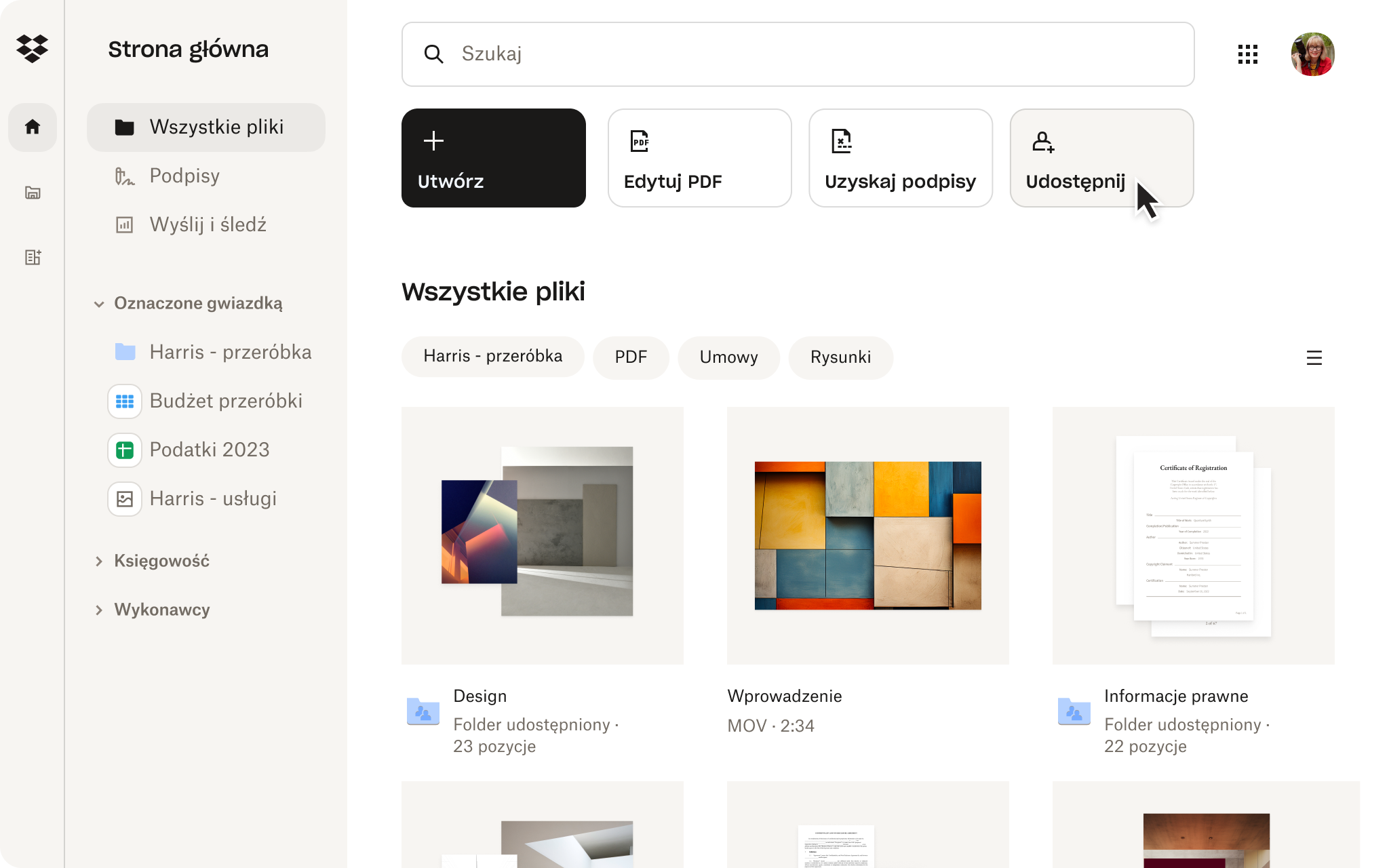Bardzo możliwe, że zdarzyło Ci się już korzystać z funkcji przetwarzania w chmurze, nawet jeśli zupełnie nic o niej nie wiesz.
„Chmurą” nazywamy „chmurę obliczeniową”. Termin ten odnosi się do zadań i usług świadczonych lub hostowanych online na zasadzie przedpłaty. Już od pewnego czasu możemy przechowywać i obsługiwać dane oraz zarządzać nimi przez Internet, jednak przetwarzanie w chmurze umożliwia to na znacznie większą skalę.
Przyjrzyjmy się bardziej szczegółowo, czym jest chmura i jak działa.
Jak działa chmura?
Po pierwsze należy wyjaśnić, że chmura mimo wszystko wymaga fizycznych elementów. Chociaż pliki nie są zapisywane bezpośrednio na Twoim komputerze, muszą być umieszczone na jakimś urządzeniu. Kiedy przesyłasz plik do chmury, używając usługi takiej jak Dropbox, zostanie on wysłany przez Internet na serwer – prawdziwy, fizyczny serwer. Dostawcy usług chmury mają setki tysięcy fizycznych serwerów zwanych łącznie „farmami serwerów”, które znajdują się w centrach danych rozsianych po całym globie.
Najprościej mówiąc, chmura jest zbiorem rozproszonych na całym świecie serwerów i centrów danych, na których przechowywane są dane. Zasadniczo jest to cyfrowy magazyn, w którym możesz przechowywać wszystkie swoje pliki. Dzięki chmurze możesz uzyskiwać dostęp do swoich danych na dowolnym urządzeniu, o ile ma ono połączenie z Internetem.
Jeśli zapisujesz plik w chmurze, przechowujesz go online. Dysponując odpowiednimi zasobami i infrastrukturą, każdy może hostować własną chmurę. Nie jest to jednak łatwe zadanie, a z pewnością nie jest ono tanie. Dlatego, mówiąc o usłudze chmury, mamy na myśli usługi na wysokim poziomie świadczone przez dostawców takich jak Dropbox.
Posłużmy się analogią do elektryczności. Korzystanie z własnego generatora prądu byłoby bardzo kosztowne i wiązałoby się z wieloma pracami konserwacyjnymi. Mamy więc dostawców energii obsługujących jeden generator, do którego dostęp ma każdy z nas, a opłaty naliczane są według zużycia. Analogicznie, bardziej wydajnym i opłacalnym rozwiązaniem jest zezwolenie dostawcy usługi chmury na hostowanie i przechowywanie danych bez konieczności tworzenia własnej infrastruktury.
Jakie są przykłady przetwarzania w chmurze?
Chmurę najprościej można określić jako rozwiązanie do przechowywania danych cyfrowych, ale istnieje o wiele więcej usług opartych na chmurze. Możemy wyodrębnić trzy podstawowe modele korzystania z chmury: „infrastruktura jako usługa” (Infrastructure as a Service, IaaS), „platforma jako usługa” (Platform as a Service, PaaS) i „oprogramowanie jako usługa” (Software as a Service, SaaS).
Infrastruktura jako usługa (IaaS)
W modelu IaaS dostawcy chmury udostępniają klientom miejsce na swoim serwerze na dowolne cele: od przechowywania danych po hosting stron internetowych. W takim przypadku klient zarządza danymi, stroną internetową czy aplikacją, natomiast dostawca udostępnia mu niezbędne zasoby obliczeniowe.
Przykładem modelu IaaS jest przechowywanie plików w Dropbox. Masz dostęp do danych, możesz je modyfikować i dodawać wedle życzenia, natomiast Dropbox zapewnia serwery do ich przechowywania. Prawie każda strona internetowa, którą odwiedzasz, jest hostowana w chmurze w modelu IaaS.
Platforma jako usługa (PaaS)
PaaS to model podobny do IaaS, jednak pozostawia on nieco więcej kontroli w rękach dostawcy chmury.
Dawniej opracowanie oprogramowania i testowanie go na miejscu wymagało dużo czasu, środków i miejsca. Obecnie model PaaS oferuje wirtualną platformę do projektowania i testowania backendów, zapewniając deweloperom wirtualną strukturę do tworzenia oprogramowania online, a serwerami i przechowywaniem danych wciąż zajmuje się dostawca. Modele PaaS oferują więc wirtualne rozwiązanie pomagające uniknąć ryzyka utraty danych i kodu związanego z tworzeniem i testowaniem na miejscu.
Oprogramowanie jako usługa (SaaS)
SaaS odnosi się do każdego typu oprogramowania, które działa w chmurze. Przykładem jest Dropbox Sign. Dzięki tej aplikacji w chmurze możesz składać podpisy na prawnie wiążące podpisy na dokumentach online, zamiast używać długopisu i kartki papieru, a dostęp do aplikacji możesz uzyskać z dowolnego urządzenia.
Modele IaaS dają więc administratorom największą kontrolę nad zasobami, zapewniając im hosting i miejsce na przechowywanie danych. Modele PaaS dają mniejszą kontrolę i służą do tworzenia oprogramowania. Modele SaaS zapewniają natomiast najmniejszą kontrolę i są skierowane do zwykłych użytkowników.

Jakie są różne rodzaje środowisk chmurowych?
Istnieją cztery podstawowe środowiska chmurowe, które mogą obejmować dowolną infrastrukturę IT.
Chmura publiczna
Chmura publiczna to taka usługa chmury, z której korzystać może każdy. Do usług chmury publicznej zalicza się Amazon Web Services (AWS), Microsoft Azure, Google Cloud, Dysk Google, iCloud i Dropbox. Każdy, kto korzysta z Dropbox, wynajmuje część miejsca na serwerach.
Chmura publiczna to wspólne środowisko podobne do dużego biura, w którym jednak każdy użytkownik końcowy ma własne bezpieczne biurko i szafkę. Ta bezpieczna dedykowana przestrzeń jest również nazywana maszyną wirtualną.
Wirtualizacja pozwala każdemu użytkownikowi końcowemu na posiadanie własnej maszyny wirtualnej w oddzielnej, bezpiecznej przestrzeni na tym samym serwerze fizycznym. Wirtualizacja pozwala zatem najlepiej wykorzystać fizyczny sprzęt serwera. Ta wydajność sprawia, że każdy może korzystać z usług w chmurze na żądanie za niewielką cenę.
Chmura prywatna
Maszyna wirtualna i cała infrastruktura chmury w chmurze prywatnej są dedykowane tylko jednemu klientowi. Ich wspólną cechą jest to, że hostowanie wciąż odbywa się online, jednak serwer, na którym przechowywane są dane, należy wyłącznie do jednego klienta. Niektórzy decydują się na prywatną usługę chmury dla zwiększenia bezpieczeństwa danych, inni z kolei chcą z jej pomocą zyskać większą wydajność.
Chmura hybrydowa
Chmury hybrydowe korzystają zarówno z serwerów wewnętrznych, jak i serwerów chmur publicznych. Większe lub bardziej poufne dokumenty można więc przechowywać w chmurze prywatnej, a pozostałe – w chmurze publicznej.
Multicloud
Multicloud oznacza, że dana firma korzysta z kilku różnych chmur publicznych, zamiast z chmury prywatnej i publicznej. Zazwyczaj dzieje się tak, ponieważ różni dostawcy usług chmury oferują różne funkcje, a niektóre firmy potrzebują ich wszystkich.
Jak firmy korzystają z chmury?
Korzyści płynące z przetwarzania w chmurze dla firm wykraczają daleko poza jej rolę jako prostego rozwiązania do przechowywania danych. Możliwość przetwarzania w chmurze bardzo pozytywnie wpłynęła na produktywność, wydajność, rozwój i dobrą organizację współczesnych miejsc pracy. Oto tylko kilka przykładów korzyści płynących z przetwarzania w chmurze.
Oszczędność
Zorganizowanie podobnych rozwiązań w siedzibie firmy byłoby niezwykle kosztowne. Dzięki chmurze utrzymywanie systemów komputerowych oraz sprzętu można zaliczyć do niepotrzebnych wydatków. Ponieważ opłaty za chmurę naliczane są na zasadzie przedpłaty, przetwarzanie w chmurze oznacza mniejsze koszty zakupu sprzętu, zatrudnienia personelu i zużycia energii. Co więcej, jeśli poświęcasz mniej czasu na kwestie informatyczne, możesz wykorzystać go na realizację swoich celów.
Odzyskiwanie po awarii
Tworzenie kopii zapasowych wszystkich zarówno ważnych plików, jak i danych w chmurze sprawia, że nie musisz się obawiać ich utraty. Przechowywanie wszystkich materiałów w jednym miejscu może okazać się niezwykle ryzykowne. Wszystko – od kataklizmu po złośliwe oprogramowanie – może niespodziewanie pozbawić Cię danych. Dlatego tworzenie kopii zapasowych danych na kilku serwerach i w kilku lokalizacjach w chmurze jest tak przydatne.
Chroń i zabezpieczaj dane
Wbrew temu, co myślą niektórzy, usługi przetwarzania w chmurze zapewniają Twoim prywatnym danym doskonałe bezpieczeństwo. Może Ci się wydawać, że najlepiej jest przechowywać wszystkie rzeczy tam, gdzie możesz mieć je ciągle na oku, jednak chmura jest trochę jak sejf w banku. Dostawcy usług chmury szyfrują dane, priorytetowo traktując ich bezpieczeństwo i ochronę.
Podobnie jak sejf bankowy jest najbezpieczniejszym miejscem przechowywania wartościowych przedmiotów, chmura została zaprojektowana tak, aby zapewniać najbezpieczniejsze miejsce przechowywania danych. W większości przypadków będziesz mógł skonfigurować własne ustawienia zabezpieczeń, tak aby pamięć masowa w chmurze działała dla Ciebie.
Skalowalność
Przetwarzanie w chmurze zapewnia firmom dodatkową elastyczność rozwoju. Im większa firma, tym więcej miejsca, czasu i pieniędzy potrzeba na jej prowadzenie. Ponieważ z chmury korzysta się zależnie od potrzeb, staje się ona wirtualnym środowiskiem, które sprzyja rozwojowi.
Z drugiej strony, jeśli Twoja firma zmniejszy skalę działalności, masz świadomość, że nie musisz płacić za sprzęt i zasoby, których już nie potrzebujesz. W przypadku usług przetwarzania w chmurze płacisz tylko za to, z czego rzeczywiście korzystasz.
Elastyczność
Jeśli wszystko, czego potrzebujesz, jest przechowywane i obsługiwane w chmurze, możesz pracować z dowolnego miejsca. Ponieważ pojęcie miejsca pracy ulega zmianom, usługa przetwarzania w chmurze odgrywa bardzo ważną rolę w funkcjonowaniu firm, pozwalając im działać zdalnie. Chmura obliczeniowa ułatwia także komunikację między ludźmi, zapewniając dostęp do plików i danych na urządzeniach mobilnych.
Współpraca
Możliwość nie tylko zapisywania, ale także tworzenia i edytowania plików w chmurze znacznie usprawnia współpracę. Dzięki chmurze obliczeniowej członkowie dziesięcioosobowego zespołu mogą przebywać w różnych lokalizacjach i pracować nad jednym dokumentem. Zarządzanie organizacją i zasobami w zespole jest więc prostsze niż kiedykolwiek przedtem.
Plusy chmury obliczeniowej do użytku własnego
Istnieje wiele sposobów na czerpanie korzyści z rozwiązań chmurowych w domu.
Najbardziej oczywistą zaletą chmury jest – oczywiście – oszczędność miejsca w pamięci urządzeń. Jeśli obecnie nie korzystasz z przechowywania w chmurze, to większość Twoich plików jest zapewne zapisana na Twoim komputerze lub smartfonie. Jeśli na tym urządzeniu zabraknie Ci miejsca, możesz dokupić zewnętrzny dysk twardy, a kiedy on również się zapełni, możesz dokupić kolejny i następne. W końcu znalezienie starego dokumentu, którego nagle pilnie potrzebujesz, nie będzie już takie łatwe.
Zapisywanie wszystkich plików w jednym wirtualnym miejscu, które nie zajmuje Twojej osobistej przestrzeni, pozwoli Ci mieć je zawsze uporządkowane i pod kontrolą bez zbędnych wydatków na dodatkowy sprzęt. Zyskasz także większą moc obliczeniową swojego systemu operacyjnego, gdyż duża część Twoich plików zostanie przeniesiona do chmury.
Chmura znacznie ułatwia też udostępnianie plików bliskim. Możesz na przykład utworzyć wspólny album ze zdjęciami, do którego dostęp będzie miała cała Twoja rodzina.
Zdefiniuj przetwarzanie w chmurze na nowo, zachęć czytelników do jego wypróbowania w celu zwolnienia miejsca na swoich urządzeniach i zakończ wezwaniem do działania dotyczącym inteligentnego obszaru roboczego Dropbox.

Proste i bezpieczne przechowywanie w chmurze Dropbox
Przetwarzanie w chmurze umożliwia dostęp do danych z dowolnego urządzenia połączonego z Internetem. A dzięki Dropbox nigdy nie było to łatwiejsze.
Dropbox tworzy pierwszy na świecie inteligentny obszar roboczy. Połączenie wszelkich treści i używanych narzędzi sprawia, że wszystko jest łatwo dostępne w aplikacji zwiększającej produktywność Dropbox. Koniec z przełączaniem się między platformami, aplikacjami i typami treści – inteligentny obszar roboczy umożliwia korzystanie z nich w jednym miejscu, zapewniając elastyczne zarządzanie IT.
I możesz mieć pewność, że Twoje osobiste pliki są tak samo bezpieczne jak dokumenty służbowe – zaawansowana infrastruktura bezpieczeństwa Dropbox chroni Twoje pliki przed nieautoryzowanym dostępem. Możesz więc zwolnić miejsce na swoich urządzeniach i przechowywać dane bezpiecznie w chmurze.
Często zadawane pytania o przetwarzanie w chmurze
Tak! Dropbox to usługa przechowywania w chmurze, która umożliwia osobom fizycznym i firmom bezpieczne przechowywanie, udostępnianie i edytowanie plików w chmurze.
Przechowywanie w chmurze hybrydowej polega na przechowywaniu plików zarówno na serwerach własnych, jak i zewnętrznych. W przypadku dużych lub poufnych plików bardziej wskazane może być trzymanie ich lokalnie. Wszystkie inne dane można natomiast zapisać w chmurze publicznej. Korzystając z usług dostawcy chmury hybrydowej, można używać obu tych metod przechowywania danych na jednej platformie.
Dostawca usług chmury to firma, która oferuje funkcje chmurowe w ramach swoich usług. Może to być platforma, infrastruktura, aplikacja lub miejsce w chmurze. Dzięki temu użytkownicy mogą oszczędzać czas i pieniądze, ponieważ nie muszą mieć własnego centrum danych i mogą korzystać z zewnętrznej usługi w miarę swoich potrzeb.
Poznaj powiązane zasoby

Czym jest wirtualny pokój danych (VDR) i kiedy jest Ci potrzebny?
Gdy w grę wchodzą duże transakcje i konieczność zapewnienia bezpiecznej współpracy, wirtualne pokoje danych okazują się niezbędne. Dowiedz się, czym jest wirtualny pokój danych i jak może on pomóc Twojemu zespołowi szybciej finalizować transakcje.

Przewodnik po komputerowym przechowywaniu danych: które narzędzie jest najlepsze do przechowywania?
Biorąc pod uwagę bogactwo oferty różnych typów urządzeń komputerowych do przechowywania danych, wybór metody przechowywania plików może wydawać się przytłaczający. Zapoznaj się z naszym przewodnikiem i wybierz opcję, która najlepiej odpowiada Twoim potrzebom.
